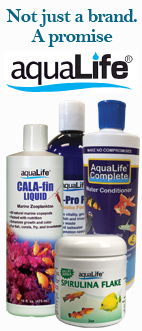|
|
Product Detail
|
|
|
 |
| Item#: |
CS8448 |
|
|
|

|
|
|
|
| Product Name: |
Arag-Alive Special Grade Reef Sand 20lb Live Sand
|
|
| Category: |
Gravel & Substrates* |
|
| Subcategory: |
Saltwater & Reef |
|
| Manufacturer: |
CaribSea |
|
|
|
|
You can now bring the world's most exotic reefs into your home with CaribSea's Arag-Alive substrates. They are developed from CaribSea's cooperation with public aquariums and zoological parks, where authenticity is a must.
·Contains specially selected strains of live marine bacteria to rapidly cycle your tank
·More than 12,000,000 heterotrophic bacteria per pound
·Unsurpassed buffering capability: keep more fish healthier, longer
· Removes Nitrate, Nitrite, Ammonia, and other wastes
·Maximum surface area, up to 10,000 square inches of surface area per cubic inch
·High uniformity coefficiently prevents biofouling
·Supports the proper pH of seawater (8.2) with the fastest reaction time
·Creates a natural biological balance to discourage nuisance algae growth
Arag-Alve line of live sands achieves rapid cycling by first preparing, and then seeding the aragonite grain surfaces with spored marine bacteria for maximum longevity and thermal resistance. These bacteria strains are specifically engineered for maximum waste reduction. Some types of bacteria reduce nitrogenous waste by metabolic oxidation while others incorporate nitrogen into bacterial biomass during the rapid growth phase. Bacteria are maintained in a spored state before introduction into an aquarium by restricting access to certain limiting factors required for active metabolism. When Arag-Alive is introduced into a new aquarium, the bacteria are activated, compressing or eliminating the ammonia cycle.
While some fishes that live over sand flats and slopes near coral reefs construct a burrow to live in, others seek shelter in and may actually swim under the substrate. Many wrasse species will dive under a fine substrate surface when they feel they are in danger. In these species, a fine substrate with a small, relatively homogenous grain size can ensure that they will not damage themselves when engaging in sand diving behavior. |
|
|
|
|
|





